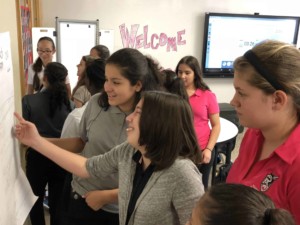Podcast: Jessie Woolley-Wilson on Intelligent Ed Tech

Early in her career and while in banking in NYC, Jessie Woolley-Wilson started tutoring kids as a service project. She felt renewed and inspired by the students she met and was impressed by their innovation, skill, and ability to thrive in scarcity. The experience launched her leadership in education technology.
After leading the pre-college and pre-graduate programs at Kaplan, she enjoyed engaging young children to help them learn how to read as President at Leapfrog SchoolHouse. She went on to lead Blackboard’s K-12 Group for five years where she learned about leveraging the power of the internet to affordably scale learning technologies.
When Netflix CEO Reed Hastings called Woolley-Wilson about DreamBox Learning, she decided to explore this opportunity and began speaking with educators on this pioneering adaptive technology. Hastings was intrigued by the adaptive direct-to-consumer math product but worried that its reach would be limited and would miss less advantaged kids. They decided to take this innovative learning platform to where all kids were – in the classroom. That meant changing DreamBox from a B-to-C company to a B-to-B company selling to schools and districts. They both knew the work would be hard, but it promised to be transformational.
Woolley-Wilson took over as CEO at DreamBox in 2010 to rebuild the product to be appropriate for a classroom setting and began focusing on serving kids and teachers in schools. She also extended the K-2 “adaptive intelligent technology” through middle school and translated every lesson into Spanish to better serve English Language Learners.
DreamBox is a K-8 adaptive math platform that delivers efficacious learning experiences to students and actionable insights for learning guardians (educators, para-professionals/aids, parents, tutors). https://www.dreambox.com/research
Individual student use calibrates the learning journey, incorrect answers mean the next challenge will be easier, correct answers boost productive struggle. “DreamBox is the only platform that is pedagogically dynamically adaptive,” said Woolley-Wilson (meaning that it can adjust the lesson/content as well as level real-time as the student uses the program).
“Ed tech has been hampered by unproven products that tend to oversimplify and over-promise,” said Woolley-Wilson. That’s why DreamBox has supported rigorous evaluation. Third-party reviewers suggest that with typical usage (five lessons a week for about 45 minutes) learners make meaningful academic progress.
Almost half of the DreamBox staff are former educators. “This Intelligent Adaptive Learning Platform was built by teachers for teachers,” added Woolley-Wilson. “We set out to build something that teachers would want to use in their classroom because they trusted it would help both them and their students be more successful.”
DreamBox uses engaging, custom-built sessions that feature embedded rewards to support great teaching and learning in the classroom. “We understand engagement, it’s not a game, but it is serious fun, and students like to use it,” said Woolley-Wilson.
Support for quality deployment has grown over time. Professional development is bundled with the product so teachers gain insights best practices. Use cases help teacher teams build productive schedules, strategies, and supports for learners.
Taking the Long View
DreamBox has attracted a unique collection of name brands impact investors including Reed Hastings, John Dorr, GSV, Charter Growth Fund, and Owl Ventures. With $130 million investment from The Rise Fund last year, the company is poised for expanded impact.
Woolley-Wilson said the cash infusion will allow the company to build better ways to serve teachers, to extend the science of learning to students and adults, to consider foreign markets and other disciplines, and to dive deep into data about how kids are thinking to make the platform even better.
As one of the few female African American CEOs, Woolley-Wilson’s corporate and community leadership keeps equity in the foreground. “To help more students of color see their spark, we need to highlight the Hidden Figures, like all women of color instrumental to the moon shot, and entrepreneurs like Kimberly Bryant, founder of Black Girls Code.”
“Young people of color need to see themselves in teachers and leaders at school,” added Woolley-Wilson.
Schools are often the place in a community where people of different races and backgrounds come together–and we need to do more to take advantage of that. Quoting social justice trailblazer Bryan Stevenson, “Proximity is key to deeper understanding, and deeper understanding is the pathway to empathy,” added Woolley-Wilson
Given climate change, race relations, income inequality, we need to prepare all students to be problem solvers, innovators, and leaders in their own communities and on the broader global stage. When we inspire all students to become life-long learners, we cultivate a sense of agency and confidence that they can work together to find solutions for the biggest challenges we face.
Key Takeaways:
[:57] Jessie speaks about her experiences at the University of Virginia and Harvard Business School.
[2:26] Why did Jessie decide to study Ed Tech at Harvard?
[4:24] Jessie speaks about her previous jobs before DreamBox and highlights her favorite one: LeapFrog!
[5:58] Jessie tells the origin story of DreamBox.
[7:00] What DreamBox means by intelligent adaptive learning.
[8:47] What drew Jessie to DreamBox Learning?
[11:02] How would Jessie describe what DreamBox is to someone who’s never heard of it before?
[11:56] How would Jessie compare DreamBox to the other similar products that are out there? Why is it a better product?
[14:24] How does DreamBox help teacher teams use DreamBox effectively at school?
[16:10] Jessie speaks about the datasets they see coming out of DreamBox — both from the side of it not being implemented correctly vs. when it is being implemented correctly.
[18:24] Jessie speaks about the DreamBox Nation platform and how it is being used for teachers to share their experiences with each other.
[19:11] How investments have helped DreamBox Learning.
[22:11] What’s on the product roadmap for DreamBox?
[27:29] What does the future of formative assessment look like? How might it be better in the future?
[29:45] Jessie shares her thoughts on leadership and what she has learned as a woman of color from leading a huge organization such as DreamBox.
Mentioned in This Episode:
Jessie Woolley-Wilson
DreamBox Learning
LeapFrog
DreamBox Nation
The Rise Fund’s Investment into DreamBox Learning
Hidden Figures (Film, 2016)
Black Girls Code
Bryan Stevenson
For more
- Meet DreamBox Learning CEO Jessie Woolley-Wilson
- New DreamBox Learning Feature Provides Personalized Learning Experiences
- The Best Impact Story in Education Keeps Getting Better (feature on Curriculum Associates)
- 5 Lessons on Impact Leadership (podcast with Rob Waldron, Curriculum Associates)
Stay in-the-know with innovations in learning by signing up for the weekly Smart Update.








0 Comments
Leave a Comment
Your email address will not be published. All fields are required.